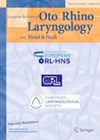
Journal Reviews
A systematic review of adjunctive probiotic therapy in the management of chronic rhinosinusitis
It is generally understood that administering substances containing live microbiologically active micro-organisms (probiotics) enhances the treatment of chronic rhinosinusitis. Probiotics manipulate and rebalance the alterations occurring in the local microbiome in chronic rhinosinusitis patients. This results in propagation of healthy...
What is the quality of patient-reported outcomes of salivary function?
Salivary gland dysfunction has multiple causes and can have significant impact on quality of life, particularly when symptoms are severe. There are several patient-reported outcomes (PROMS) that assess these issues; however, these are variable in what they measure. This systematic...
Systematic review and meta-analysis showing benefit of cochlear implantation in adults with single-sided deafness
This article presents results of a systematic review and meta-analysis to further investigate the impact of unilateral cochlear implantation (CI) in adults with single-sided deafness (SSD) with regards to speech perception in quiet and noise, tinnitus, sound localisation and quality...
Age and sleep disorders as risk factors for Ménière’s disease
Decades after it was first described, the pathophysiology of Ménière’s disease is still a subject for research and discussion, with several controversies regarding its management. Several factors have been reported to cause Ménière’s disease including viral infections, allergies, genetic factors,...
REVISIONS acronym for preoperative imaging review in revision endoscopic sinus surgery
The authors have developed an acronym to aid evaluation of preoperative sinus CT imaging in revision endoscopic sinus surgery (RESS). To determine which pertinent aspects of anatomy to include, a systemic review of studies that investigated anatomic contributions to persistent...
Global incidence of sporadic vestibular schwannoma
The incidence rate of sporadic vestibular schwannoma (VS) has commonly been quoted as one in 100,000. However, since the advent of screening for asymmetrical hearing loss and increased availability of modern MRI scanning, more recent studies have shown the incidence...
Inpatient or outpatient thyroidectomy?
This systematic review and meta-analysis discusses the safety of hemithyroidectomy in an outpatient vis-à-vis an inpatient setting. Thyroidectomy has traditionally been performed as an inpatient procedure. Currently, an increasing number of surgeons are performing thyroidectomy in outpatient settings. The main...
Should we be utilising the pre-lacrimal approach for maxillary sinus inverted papilloma?
For some time now, gold standard management of the maxillary sinus inverted papilloma has been endoscopic medial maxillectomy (EMM). Recently the endoscopic prelacrimal recess approach (EPLRA) has been reported to provide good access whilst preserving the nasolacrimal duct and inferior...
Pharmacological treatment of glue ear in children
Otitis media with effusion (OME), also known as glue ear, is a common cause of hearing loss in children. Most cases resolve spontaneously within three months. Early and proper management of OME can help avoid hearing and speech impairment that...
Remote consultations: bringing ENT in to the 21st century
The ongoing peaks and troughs of the COVID-19 pandemic have imposed unprecedented challenges on day-to-day healthcare provision that we all took as given across the globe prior to spring 2020! The pandemic has, in many ways, made us push boundaries...
Cuff up or cuff down; to occlude or not to occlude? What effect does tracheostomy tube modification have on swallowing outcomes?
Dysphagia is commonly seen in patients with tracheostomy. The current global pandemic has increased interest in the impact of a tracheostomy on swallowing outcomes. This systematic review is therefore a timely addition to the literature and a useful read for...
Hearing outcomes after retrosigmoid resection of smaller vestibular schwannomas are better
The authors reviewed published literature reporting hearing outcomes in patients after retrosigmoid (RS) resection of vestibular schwannoma (VS). Aggregate hearing preservation of 31% and 35% under fixed and random models respectively was observed in the 2034 patients meeting eligibility criteria...
















